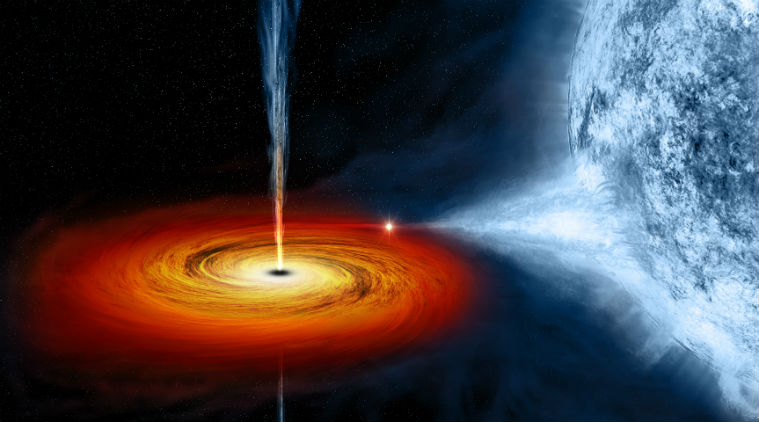The first-ever photographic image of a black hole could be revealed on Wednesday
In a major breakthrough for cosmological research, astronomers have announced that they will reveal the first-ever photographic image of a black hole.
 A black hole’s event horizon, one of the most violent places in the universe, is the point of no return beyond which anything gets sucked in irretrievably. (Image: NASA)
A black hole’s event horizon, one of the most violent places in the universe, is the point of no return beyond which anything gets sucked in irretrievably. (Image: NASA)
Astronomers have announced that they will reveal the first-ever photographic image of a black hole on Wednesday. As per the US National Science Foundation website, the final results from Event Horizon Telescope (EHT) project will be announced via a press conference tomorrow on April 10 at 9:00 am EDT (Eastern Time), that translates to 6:30 pm IST (Indian Standard Time).
The EHT project is an international partnership formed in 2012. Its main objective is to directly observe the immediate environment of a black hole. The findings will provide insight into the celestial object so dense that their gravitational field swallows everything including light.
EXPLAINED | Here is a black hole, and why none was photographed before
Simultaneous news conferences are scheduled in different parts of the world including Brussels, Shanghai, Tokyo, Santiago and Taipei.
Black holes are extremely dense pockets of matter with incredible mass and minuscule volume. They drastically warp the fabric of space-time and anything that passes too close gets sucked into it be it a wandering star or a photon of light. Black holes exist from the size of a human cell to more massive than the sun.
Black holes of stellar mass are formed when a massive star collapses at the end of its life cycle. After a black hole forms, it continues to grow by absorbing mass from its surroundings.
To get to the findings, the EHT looked at two supermassive black holes– Sagittarius A* and M87. The Sagittarius A* is situated at the centre of our own Milky Way galaxy, possessing mass four million times the mass of our sun and located 26,000 light years from Earth. The M87 resides at the centre of the neighbouring Virgo A galaxy, possessing a mass 3.5 billion times that of the sun and located 54 million light-years away from Earth.
According to EHT project astrophysicist Dimitrios Psaltis, the new findings will test legendary physicist Albert Einstein’s theory of general relativity, reported Reuters. The theory was put forward in 1915, with an intent to explain the laws of gravity and their relation to other natural forces.
Also read | Some black holes may let you live out infinite futures by erasing your past, finds study
The new observations will be used to detect evidence of what happens at the edge, or shadow, of a black hole. If Einstein’s predictions are correct, it will permit accurate measurements of the object’s size and shape.
“The shape of the shadow will be almost a perfect circle in Einstein’s theory,” Psaltis stated, adding, “If we find it to be different than what the theory predicts, then we go back to square one and we say, ‘Clearly, something is not exactly right,” cited Reuters.







